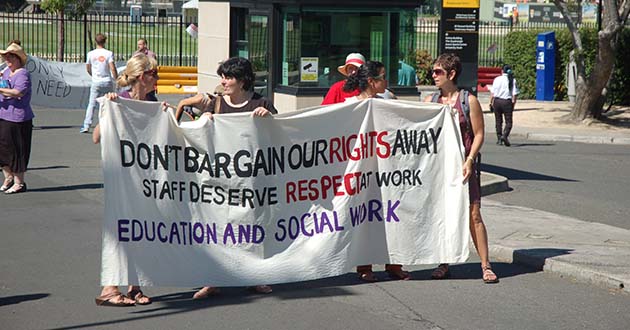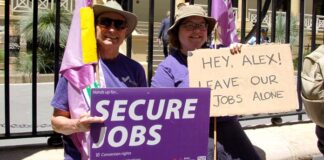The acceptance of enterprise bargaining has seen union officials trade away rights like penalty rates, preparing the ground for the Fair Work decision, writes James Supple
Sally McManus, secretary of the peak union body the ACTU, has called for action to “change the rules” over industrial relations. Workers’ reduced bargaining power and restrictions on the right to strike are driving inequality and low wages growth.
The decision to cut penalty rates for workers in retail, fast food, pharmacies and hospitality by the so-called “Fair Work Commission” is a graphic example of how the system is failing workers.
But it has also been the willingness of union leaders to work within the industrial relations system, trading away conditions like penalty rates, which led to this situation.
Today’s industrial relations framework was established by the shift to enterprise bargaining under Paul Keating’s Labor government. This began in 1991, initially with the support of the ACTU.
It spread rapidly from 1994, when Keating’s Industrial Relations Reform Act entrenched enterprise bargaining as the main mechanism for winning pay rises. Before this industry-wide Awards determined in the Industrial Relations Commission had been more important.
Central to the new system was the idea that wage rises should be contingent on agreeing to “trade-offs” by sacrificing conditions to ensure “productivity increases” for business. Keating himself said in 1991 that enterprise bargaining was necessary so that businesses could, “obtain the great productivity advances available from changing workplace arrangements and conditions”. What this really meant was forcing us to work harder and longer in order to boost corporate profits.
It was also enterprise bargaining legislation that restricted “legal” industrial action to defined “bargaining periods” when negotiating a new enterprise agreement. Strike action around any issue that emerged after bargaining was finished, whether job cuts, safety breaches or other workplaces changes, became illegal.
Basing negotiations at a workplace or enterprise level, as opposed to industry-wide, was designed to force workers to take responsibility for profits at the company where they worked.
Penalty rates and shift loadings paid for working outside usual hours were among the first conditions to be traded away, as bosses pushed for more “flexible” hours of work.
One way of doing this was to lengthen “ordinary working hours”. This meant extending the hours when employees could be required to work, and often abolishing penalty rates during these hours.
In 1994 the Commonwealth Bank and Advance Bank used enterprise bargaining to introduce work at ordinary rates, without penalties, on evenings and weekends. Email Appliance factories began paying ordinary rates for any work between 6am and 6pm.
Rodney Adler, boss of insurance company FAI, boasted that enterprise bargaining meant, “We can now operate until 9pm, seven days per week during holiday periods without paying penalty rates.”
Even where penalty rates were retained, bosses used the new system to impose around the clock shift work. Academics at the Workplace Research Centre at Sydney University tracked the impact of the new system. In 1997, they wrote, “It is clear that working time arrangements in Australia are being transformed. Fewer employees now work ‘standard’ hours.”
At Coles and Bi-Lo, unions agreed to a deal in 1996 that saw “ordinary hours” redefined to cover 24 hours a day, seven days a week.
Other employers simply demanded an increase in the working day. At Alcoa the work week was extended from 38 to 42 hours, while Richmond Council in Melbourne increased the working day from 7.2 to 7.7 hours.
Elsewhere, bosses used enterprise bargaining to impose job cuts. Qantas cut over 3000 jobs in exchange for a 6 per cent pay rise over two years.
Enterprise bargaining did deliver pay rises, at the expense of these “trade-offs”. A “no disadvantage test”, which still applies today, meant agreements were supposed to leave workers better off overall.
But that wasn’t how most workers saw it. Around 60 per cent reported an increase in work effort and between 50 and 60 per cent said work had become more stressful, according to government surveys collected in the first two years of the new system. One quarter of workers reported working overtime, and almost half of them were doing it unpaid.
Enterprise bargaining also increased inequality between workplaces and eroded solidarity between workers within an industry. Workers at well organised companies where the union was strong were able to extract higher wage gains and keep more of their conditions. Other workers in the same industry might be left with much lower wages and conditions.
In construction, workers at large projects run by the big companies have been able to win significant wage increases and rostered days off. But workers on smaller, suburban sites where the union does not organise get less.
Bosses have also been able to “divide and rule”, even within companies, by dividing workers up into different sections. Agency bargaining in the public service, for instance, meant that the workforce had to negotiate enterprise agreements agency by agency as opposed to one agreement for the whole workforce. This has eroded solidarity between workers who might be in the same union, but get vastly different conditions. The end result is lower union bargaining power overall.
Union officials’ role
Union officials and many workplace delegates swallowed the idea of helping the bosses improve productivity, imposing the measures on the workforce that were making them work harder.
Not surprisingly, many workers began to resent the way their own union representatives were working with management to cut their conditions. At the ANI Bradley foundry in Brisbane the tensions even led to a fist fight between the union delegate and another worker.
The decline in union membership accelerated, as less and less workers saw the point in being in a union, falling from 40.5 per cent of the workforce in 1990 to 28.1 per cent by 1998.
There was a decrease in secure, full-time employment and an increase in casualisation, from 15.8 per cent of the workforce in 1984 to 27.7 per cent in 2004. The growth in part-time work has also meant more precarious employment for many, with a third of all part-time workers without guaranteed hours of work each week.
This same approach to workplace bargaining continues today. Its outcome was exposed in the appalling deals agreed by the SDA at employers like Coles and Woolworths that, in some cases, scrapped penalty rates altogether.
The agreement at Coles was so bad that it left workers worse off than the basic Award, supposedly a minimum legal standard. The SDA argued that workers got an hourly pay rise under the deal, but that was little solace for the many part-time and casual workers who lost their penalty rates.
The agreements at other big retail employers are just as bad. Payslips from Woolworths, KFC and Hungry Jack’s examined by Fairfax newspapers show workers there had been underpaid by millions of dollars, compared to what they would have got under the basic Award.
Trading away penalty rates created the ground for the Fair Work decision in February that cut them across the board for retail, fast food and hospitality workers. Once unions agreed to start scrapping penalties in enterprise bargaining agreements, it helped erode the idea that workers should be paid more for working on weekends and public holidays.
And it is not just the SDA selling out workers. Labor leader Bill Shorten has been embarrassed by media scrutiny of deals his old union, the AWU, agreed when he was at the helm and shortly after. But the whole union movement accepted the idea of trade-offs and sacrificing conditions as part of enterprise bargaining.
Opposition
Right from the beginning of enterprise bargaining, there was significant opposition to the trade-offs and cuts to conditions from rank-and-file union members.
A number of workplaces rejected deals approved by their union officials. In early 1994 workers at the Sheraton Wentworth Hotel in Sydney voted down a deal promoted as “exemplary” by the ACTU. Their union officials had already implemented it at two other Sheraton hotels. It scraped penalty rates, absorbing them into workers’ annual salaries so that management could have “flexible” rostering.
Most union officials agreed to deals cutting conditions, arguing they were the only way to get a pay rise. But there were a handful of disputes that showed a way to win pay increases without trading off conditions—organising an industrial fight. In 1994, the year enterprise bargaining began in earnest, firefighters in NSW won a 13 per cent wage rise after refusing to accept trade-offs. They voted down five shoddy deals and imposed work bans and rolling strikes.
Workers at Franklins warehouses in NSW held a week-long strike the same year against efforts to introduce speed-ups and increase casual staff, forcing the company to both retreat on the trade-offs and agree to an immediate pay rise.
It is only such a fightback in the workplaces that can defend penalty rates, stop the erosion of pay and conditions and build union strength. This will require defying the industrial relations laws that restrict the right to strike and make it harder to organise effective union action.
Sally McManus’ comment that unfair laws need to be broken was celebrated across the union movement. But these words need to be put into action. The outcome of enterprise bargaining has shown that there is no chance of partnership between bosses and workers where both benefit.
There has to be an end to the acceptance of trade-offs and efforts to help business boost productivity and profits. And unions need to reject the straight-jacket of enterprise bargaining and fight for industry-wide conditions and pay rises using the “pattern bargaining” that our industrial relations system has tried to ban.
We need to fight both the bosses and the law in order to win gains on pay, rights at work and union power.
Further reading
Enterprise bargaining: A no win game for workers by Tom Bramble






